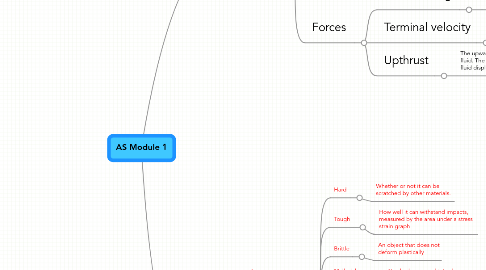
1. Fluids
1.1. Density
1.1.1. Density = mass / volume
1.1.2. Pressure = height x density x gravitational field strength
1.2. Flow
1.2.1. Laminar Flow
1.2.1.1. At low Flow rates laminar flow occurs, with smooth streamlines and very little friction between layers. It has a conical velocity profile.
1.2.2. Turbulent Flow
1.2.2.1. At high flow rates turbulent flow occurs, with eddies and a flat velocity profile.
1.3. Viscosity
1.3.1. Temperature
1.3.1.1. The higher the temperature the lower the viscosity.
1.3.2. Experiment
1.3.2.1. liquid flowing through a small tube with a constant head of pressure. Measure time for volume of liquid to flow through. Repeat for range of temperatures of liquid
1.4. Forces
1.4.1. Viscous Drag
1.4.1.1. When objects move through fluids they experience viscous drag. This depends on the viscosity of the fluid.
1.4.1.1.1. Stokes Law F=6πnrv
1.4.2. Terminal velocity
1.4.2.1. When weight = viscous drag + upthrust the object stops accelerating and reaches terminal velocity
1.4.3. Upthrust
1.4.3.1. The upwards force on an object in a fluid. The upthrust equals the weight of fluid displaced
1.4.3.1.1. an object floats if upthrust = weight
2. Solids
2.1. key terms
2.1.1. Hard
2.1.1.1. Whether or not it can be scratched by other materials.
2.1.2. Tough
2.1.2.1. How well it can withstand impacts, measured by the area under a stress strain graph
2.1.3. Brittle
2.1.3.1. An object that does not deform plastically
2.1.4. Malleable
2.1.4.1. Can be hammered into shape
2.1.5. Ductile
2.1.5.1. Can be drawn into wire
2.1.6. Stiff
2.1.6.1. The more force needed to achieve a fixed extension the stiffer the material. The greater the gradient of stress strain graph the stiffer.
2.1.7. Strong
2.1.7.1. How much force is needed to break it. The higher the line goes on a force extension graph the stronger.
2.2. Stretching solids
2.2.1. Stress
2.2.1.1. The extension / original length
2.2.2. Strain
2.2.2.1. New node
2.2.3. Youngs Modulus
2.2.4. Stress Strain Graphs
